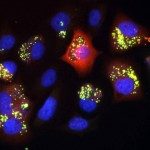Link to Pubmed [PMID] – 31476368
Link to DOI – S1047-8477(19)30182-010.1016/j.jsb.2019.08.012
J Struct Biol 2019 11; 208(2): 182-190
Mycobacterial KGD, the thiamine diphosphate (ThDP)-dependent E1o component of the 2-oxoglutarate dehydrogenase complex (OGDHC), is known to undergo significant conformational changes during catalysis with two distinct conformational states, previously named as the early and late state. In this work, we employ two phosphonate analogues of 2-oxoglutarate (OG), i.e. succinyl phosphonate (SP) and phosphono ethyl succinyl phosphonate (PESP), as tools to isolate the first catalytic steps and understand the significance of conformational transitions for the enzyme regulation. The kinetics showed a more efficient inhibition of mycobacterial E1o by SP (Ki 0.043 ± 0.013 mM) than PESP (Ki 0.88 ± 0.28 mM), consistent with the different circular dichroism spectra of the corresponding complexes. PESP allowed us to get crystallographic snapshots of the Michaelis-like complex, the first one for 2-oxo acid dehydrogenases, followed by the covalent adduction of the inhibitor to ThDP, mimicking the pre-decarboxylation complex. In addition, covalent ThDP-phosphonate complexes obtained with both compounds by co-crystallization were in the late conformational state, probably corresponding to slowly dissociating enzyme-inhibitor complexes. We discuss the relevance of these findings in terms of regulatory features of the mycobacterial E1o enzymes, and in the perspective of developing tools for species-specific metabolic regulation.


